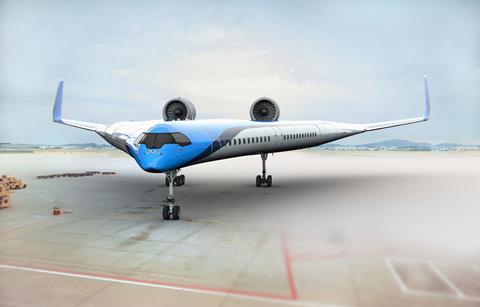A scaled model of the ‘Flying-V’ blended wing aircraft concept — first unveiled by Dutch researchers last year — has completed its first test flight in Germany.
Airbus also emerged as the latest partner in the project, after Dutch flag carrier KLM threw its weight behind the project last year.

Delft Technical University (TU Delft), which is developing the project, states that the maiden sortie took place at an undisclosed German airbase, where they had support from an Airbus team.
The scale model weighs 22.5kg, has a wing span of 3.06m and a length of 2.76m. It was controlled via radio link, with TU Delft PhD candidate Nando van Arnhem as the drone pilot.
Its two 4kW electric ‘ducted fan’ engines are powered by a 6kg lithium polymer battery.
The test model performed a series of tasks, including take-off, manoeuvres and approaches, until its batteries were nearly empty, before it landed.
Says team leader Roelof Vos, an assistant professor of flight performance and propulsion at TU Delft: “One of our worries was that the aircraft might have some difficulty lifting-off, since previous calculations had shown that ‘rotation’ could be an issue. The team optimised the scaled flight model to prevent the issue but the proof of the pudding is in the eating. You need to fly to know for sure.”
Vos notes that thrust was good and flight speeds and angles were as predicted by the team.
However, he adds that the current scaled model design “makes it difficult to keep the wings level, and caused the aircraft to have a somewhat rough landing”, something that was also predicted in initial estimates.
To this end, the team will make use of the data collected to create an aerodynamic model of the scaled flight model. It will also take the model out for more test flights.
The Flying-V concept was first publicised at the sidelines of the IATA Annual General Meeting in Seoul in June last year, when KLM signed an agreement to support its development.
The concept features a V-shaped design that is passenger cabin, fuel hold and wings in one, powered by a pair of rear-mounted turbofan engines.

It promises up to 20% better fuel efficiency compared to an A350, and is around 15% more aerodynamically efficient compared to conventional aircraft. In its baseline configuration, the Flying-V would seat about 314 passengers in two classes.


























